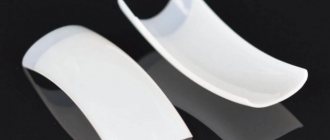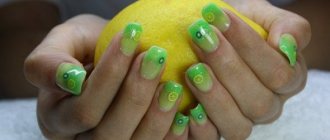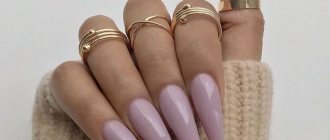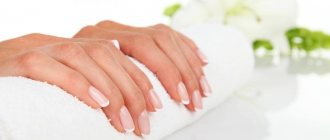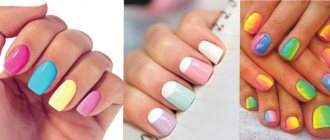Acrylic was the first material used to create artificial nails. Back in the 60s of the last century, a dentist who had previously made dentures from acrylic pleased his wife with artificial nails. Gradually the material gained popularity. Unlike gel, acrylic nail extensions do not require an ultraviolet lamp. This material hardens perfectly in air in a few seconds.
Technology on tips
Nail extension with acrylic on tips involves a similar technology using all the components. The process will require plastic, transparent tips, glue, and tongs to shape the nails.
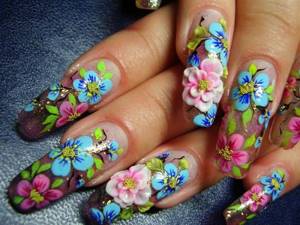
It’s not difficult to build up on forms, but on tips it’s much easier. You need to start by cutting the length of the platinum, processing the cuticle and removing the dermis film.
The next step is to apply glue to the tip and fix it on the nail. Tips are glued to the middle of the nail and trimmed to the desired length.
The surface of the nail plate and tips are cut off with a buff, forming a rough structure. Apply primer and begin laying out acrylic. In the process of moving from the nail plate to the free edge, forceps are used to give a perfectly even shape from the sides. Use a file to file down uneven surfaces and create a glossy finish. The final stage is design.
Step-by-step acrylic extension onto molds at home for beginners
- The hands of the master and the client are cleaned and disinfected.
- A file removes the fatty layer from the surface of the natural nail.
- The nail plate is freed from skin formations and cuticle.
- Apply the degreaser, do it very carefully, you can even dip your fingertips in it and let your nails dry.
- Apply primer. As soon as the nail turns white and the scales open, it moves on to the next stage.
- A mold is placed on the tip of the finger, then it is given the necessary bend.
- The surface is re-treated with a primer.
- Wet the brush in the monomer and distribute the resulting ball over the nail, forming a plate; this must be done quickly enough, before the mixture dries - after the material has completely dried, the forms are removed.
- The sides of the nail are filed down and then the tip is shaped.
- The surface is sanded with a buff to a glossy shine.
- Apply cuticle oil.
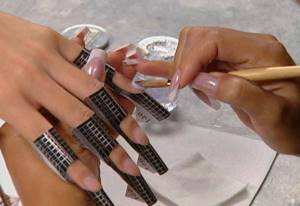
Step-by-step video on how to do acrylic nail extensions
We invite you to watch a detailed master class on extensions. You will see how to prepare your nails, how to properly attach the form, how much acrylic beads to apply, and their even distribution.
https://www.youtube.com/watch?v=w0LqW-_xm0EVideo can't be loaded because JavaScript is disabled: Acrylic nail extensions. Master class on manicure from Evgenia Isay (https://www.youtube.com/watch?v=w0LqW-_xm0E)
Here you can learn how to apply a French manicure to extended nail plates. The master shows how to draw a smile evenly using a brush.
https://www.youtube.com/watch?v=ydwS9gdtWzIVideo can't be loaded because JavaScript is disabled: French manicure for extended nails (https://www.youtube.com/watch?v=ydwS9gdtWzI)
Now you know what acrylic coating is and how to make it yourself at home. This procedure is considered expensive, so it may not be affordable for everyone. If you wish, you can purchase all the necessary materials and make such creations yourself at home. After all, now you know what tools are needed for this, and what the application process is like. Using the video for beginners and additional lessons, you can fully understand the basic secrets and tricks of acrylic nail extensions.
Fashion ideas
After modeling the shape and length, we move on to the coating. We remember that acrylic cannot be varnished, so we will use acrylic paints.
French
The classic nail design is French. There are many varieties of it, so girls often prefer it. French can be done during and after acrylic nail extensions. Its classic version is a pastel beige or pink base and a white smile along the growth line of the marigolds. But, if desired, you can combine a variety of colors with each other.
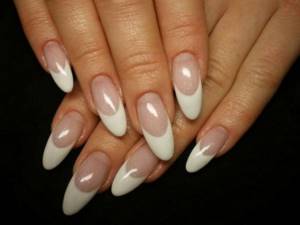
Often the best decor for a French jacket is flowers. For everyday wear, a manicure made with calmer, pastel colors is suitable. If you are going to a festive event, you can use natural shades that match your outfit, additional shiny elements in the form of rhinestones, bouillons, kamifubuki, shiny dust.
Stickers
There are a wide variety of stickers that you can use to create a real work of art on your nails. For summer design, use bright colors, stickers in the shape of fruits and berries. Cartoon characters will be relevant for young girls, flowers and patterns for more mature ladies.
Summer trendy ideas
In the summer, you want to surround yourself with bright colors as much as possible, so they are often used when creating a summer manicure. Nowadays, mint, peach, and bright yellow colors are popular, so they can be used to maintain a Frenchman’s smile or draw an original design.
Wedding ideas
Brides often carry out extension procedures, because on such a special day they pay special attention to all the details of the image. Often the design is chosen in white because it emphasizes innocence, tenderness, and beauty. A classic French jacket, decorated with lace and a bow on the accent finger, looks very gentle.

Dark design
Dark colors look quite original on long nails. You can try a black and white classic, decorated with rhinestones, or a dark blue glossy shade. The most daring girls choose red shades that emphasize their femininity and sexuality. Often colors are chosen to match the tone of the outfit and mood.
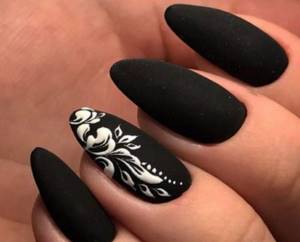
Brilliant decor
When you want something unusual, girls choose shining decor. Nowadays there are a large number of shiny decorations for nail art. You can create a Frenchie’s smile with shiny silver polish, decorate accent fingers with rhinestones, and add sparkles to the decor of each nail. Before using rhinestones, make sure that you will be comfortable wearing them every day.
Acrylic extension: fly in the ointment for nails
Even if the instructions have been fully studied and followed, all materials are of high quality and tested, some things cannot be protected from. Disadvantages of acrylic extensions:
- Unpleasant odor during the procedure. It goes away quickly after the process is over.
- This is very harmful for nail psoriasis or other fungal diseases. Get treatment first.
- With prolonged extension, the consequences for nails are unpredictable. Under acrylic, the plate does not breathe and does not receive the substances necessary for growth.
- This procedure can only be performed at home under the guidance of a professional or after completing special courses.
- In case of an allergic reaction, you urgently need the help of a specialist! Don’t wait for it to “go away on its own.” Acrylic extensions are a very responsible process.
It will definitely be interesting to read:
- Step-by-step video instructions for correcting gel nails
- How to quickly restore nails after extensions?
- Step-by-step instructions for covering nails with biogel at home
Acrylic design

Due to the fact that acrylic nails are very hard and smooth, they allow you to create any design you want. But the most interesting is the one that cannot be repeated on any nails except on acrylic. This is an acrylic sculpture. It involves the formation of three-dimensional figures on an acrylic nail. They consist of the same powder and monomer. These can be a variety of flowers, butterflies, lizards, etc. They can be made either directly in color, using colored acrylic powder, or from white acrylic and painted on top with acrylic paints.

This design can be complemented with rhinestones, drawings, stickers and other means. Here everything depends on the imagination of the master and the wishes of the client. The sculpting looks equally good on nails painted in one color and on a French manicure.
The inability to perform such a design on gel or natural nails is explained by a number of objective factors. Firstly, the weight of the molding is quite large, which significantly loads and injures the natural plate and can cause it to crack and delaminate. As for gel nails, this fragile material also cannot withstand the significant weight of the sculpt.
In addition, an acrylic sculpture obtains good adhesion to the plate only if it consists of the same material, thus, high-quality bonding with gel will not work. Also, the plate at the base must be completely smooth; this is almost impossible to achieve by mechanically strengthening natural nails with gel.
Required materials and tools
The implementation of the procedure is preceded by preparatory work, which includes the preparation of all necessary materials and tools.
To carry out the extension, you will need to prepare the following minimum set of devices:
- Acrylic powder intended for the production of working mass.
- The monomer is in a liquid state, which is required to dilute the base material; without it it will not acquire the required consistency.
- Any product intended for disinfection activities.
- Primer.
- A cosmetic type of glue.
- A means for applying a fixing finishing coat.
- A special brush for working with the material, as well as means for cleaning it.
- A set of various files for surface treatment.
- Forms or tips depending on the chosen technique.
- Orange sticks.
You can also purchase ready-made kits, which include everything you need for extensions. People carrying out the procedure for the first time are recommended to use this option to eliminate the risk of purchasing products that are incompatible with each other or an unsuitable instrument.
Laser correction of ingrown toenails
A separate topic for many girls is the correction of ingrown nails with a laser device. This technique appeared relatively recently, but quickly became the most effective in solving this problem.
An ingrown toenail is an unpleasant and dangerous phenomenon. For example, if it grows into the leg, it can cause gait distortion or injury. For some time, a pedicure on the foot can save you from it, but often the effect lasts for less than 2 weeks.
How to perform laser correction of a toenail step by step:
The technology includes exclusively medical intervention. You shouldn’t expect them to give you a pedicure or file a plate – this is what beauty salons do. First, you will need to fill out some paperwork and choose a suitable painkiller, then, together with your doctor, decide on the type and strength of the laser beam; Pain relief can be carried out with lidocaine subcutaneously or using special creams (ointments); The skin ridge is removed first. It is this that is the main cause of improper growth of the plate. The doctor simply burns it out with a carbon laser; Under the ridge there is almost always a process, which is the main cause of ingrowth. It is adjusted using tweezers and supported with gauze turunda for fixation; The treated area will require special care for several days.
If it’s summer outside, it’s important to avoid dust and dirt, and also avoid swimming in open water; if it’s winter or autumn, it’s recommended to wear loose shoes.
The average price of laser correction is $10 per session. To find out exactly how much a procedure costs, you need to consult with a doctor personally, demonstrate the scope of work and choose the optimal treatment option.
For several years now, shellac manicure has been steadily gaining popularity. And all thanks to the natural appearance of the nails covered with it, reliability and durability. But this coating also has one small drawback - the need for periodic correction. How to make it at home?
Methods of acrylic nail extensions
We'll help you choose!
If you don’t know what to choose for extensions - gel or acrylic - read our article in which we described in detail the advantages and disadvantages of both methods.
There are several techniques for working with the material. When choosing, you need to take into account the fact that this is a quickly hardening material. Therefore, the procedure should be performed quickly and it is advisable to practice several times before you begin the “control” attempt.
Acrylic extension techniques:
- For tips;
- On the forms.
Extending nails with tips is a very fast way: you can get beautiful nails in less than an hour. Disadvantage - you cannot make thin, pointed claws. Of course, you can try if you want, but the process of cutting out tips will be long and painstaking. Most often, tips are used for wide, square-oval nails.
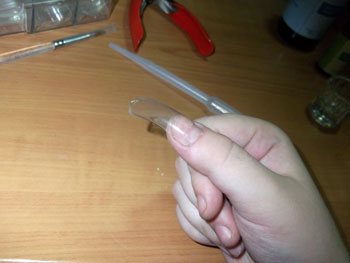
When extensions are applied to forms, you can get absolutely any type of nails.
Forms for extensions are:
- Upper. The material is laid out on the recess inside the form and then pressed against the treated nail.
- Lower ones. Small balls of acrylic are laid out with a brush, and a nail of the required shape and length is made.
The technique of laying acrylic on top of a mold with a brush is the most painstaking and time-consuming. If a beginner chooses this method, he will have to practice many times. An alternative is top forms. The technique is easier, the nails are smoother.
Extension instructions
We have already mentioned two methods of acrylic nail extensions. Now let’s take a closer look at the main steps that need to be taken to achieve a stunning effect when using each.
The technology using tips involves the following steps:
- Trim your nails short.
- It is necessary to remove the shine and make the surface of the nail rough (for better adhesion to the tip) by treating it with a nail file.
- Clean cuticles.
- Select the desired size and shape of the tips.
- Degrease the surface with alcohol.
- Apply glue to the tip of the tip and press it onto the nail for 20 seconds. Alternately apply glue first to one hand, then to the other.
- After completing the previous step, trim off the excess.
- Use a nail file to remove excess shine to give a natural look and even out the border.
- Remove dust with a brush if necessary.
- Treat the surface with primer and wait until it dries.
- Take a monometer, acrylic and a brush. First, dip the brush into the strengthening solution and then into the acrylic so that a ball forms at the tip of the brush, and begin applying the manicure from the little finger from the tip to the base. You can lay out three balls - the smallest one in the cuticle area (in this place you need to apply a very thin layer), the middle one - on the free edge area and the large one - in the stress area.
- When everything is dry, you need to smooth out all the unevenness and give the nail the required width and length.
- Coat your nails with oil to ensure shine.
These simple techniques will help you achieve no worse results than in a beauty salon. Just try it and you will be surprised how easy it is.
Popular articles May greetings
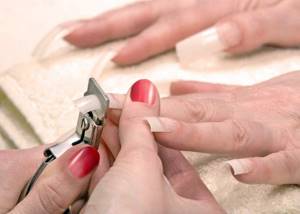
There are other ways to work with the acrylic component. We also remembered them. Now let's figure out how to work with them.
The technology of extension to lower forms is performed as follows:
- Wash your hands and clean with disinfectant.
- Use a nail file to file down the top coat of the nail to even out the surface. Then remove the dust with a brush or something else.
- Clean the cuticle, pushing it towards the base of the nail.
- Apply primer.
- Put the form on and bend it, secure it in the middle and press it.
- It is necessary to connect the ends of the form, but remember that the ends should not be closed to ensure the correct shape of the nail.
- Apply primer again. Place a white acrylic ball on the mold and distribute evenly.
- We draw a smile, for which we use liquid in which we dip a brush.
- Place a pink ball on the natural nail so that the white and pink colors barely touch. The second ball must be applied to the cuticle area. The sides and entire surface must be level.
- Remove the form after the paint has dried, level and sand the surface of the nail with a nail file.
- Lubricate the surface with oil and apply clear varnish to enhance the effect.
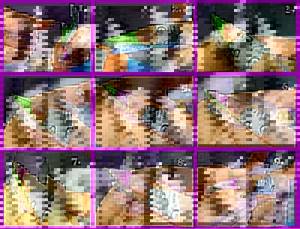
You can also use another technology for working with forms - extension to upper forms, in the following stages:
- Clean the surface of the nail in the same way as when applying extensions to the lower forms.
- Choose the top shapes you want.
- Apply three balls of acrylic on them and distribute evenly along the length of the nail.
- Place the mold on a natural surface and remove any excess with a stick.
- Leave it for a few minutes (7-10) to dry.
- Remove the form and use a nail file to give the nail the desired look.
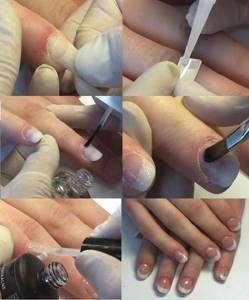
Try the following technologies for working with marigolds. You will definitely be pleasantly surprised by the result of your skills and abilities. You didn't even suspect that everything was so simple. Now you can easily open your own home beauty salon and give spectacular manicures to yourself and your friends.
Always be on top, dear women, because your beauty can really save this world!
Drying the primer
Those who are interested in how to properly dry primer on nails, in a lamp or in the open air, need to know that these preparations are divided into two groups. The first is self-affirming. There is no need to dry them in a lamp; just leave them in the open air for a few minutes, trying not to catch the coating with foreign objects. Such drugs include the popular Bluesky. Its affordable price and excellent properties have made the product popular with many beauties.
The second type is light-curing. This preparation is dried only with the help of a lamp. It cannot harden in air. The drying time of the drug can be found on the packaging in the manufacturer’s instructions.
There is no need to determine the time the nails are under the lamp by eye; it differs for each type of preparation. Prolonged drying can harm your nails, and a shorter period than indicated on the package will not allow the coating to fully harden.
Most of the products produced are self-curing. This is more convenient for those who do their own manicure at home. After all, not every girl has the opportunity to purchase a special lamp because of its cost.
Before purchasing a primer, be sure to carefully read the instructions. It indicates how to dry the drug - in the open air or under the rays of a lamp. You cannot experiment if it is indicated to dry without any impact - do so.
Be prepared for the fact that after the product dries, the nail may become matte. This does not happen with all means. For example, bluesky makes the coating shiny and transparent.
Some types of preparations take quite a long time to dry. You cannot apply gel polish until the base layer has hardened. Otherwise, instead of a perfect smooth finish, you will end up with an ugly manicure with folds, which will not give you originality.
The shelf life of the primer can be found on the packaging. It is not recommended to use an expired drug. It may become oily and very thick, in which case you will need to buy a new one. Store the product in a cool, dark place; sunlight has a detrimental effect on it.
Now you know what a primer is and whether it needs to be dried in a lamp. Don’t be lazy to read the instructions that manufacturers provide for each cosmetic product, then you will never have problems. Use primer and be proud of your beautiful manicure in any life situation and at any special event.
Advantages and disadvantages
Acrylic extensions allow you to create natural-looking nails due to the elasticity of the material used. They will be thin, but at the same time persistent and able to last quite longer than the same gel. Acrylic extensions can be removed independently using a certain solution and any damage can be restored. In addition, this type of coating does not limit the possibility of using various techniques and implementing designs. Finally, it is worth mentioning that acrylic nails are not subject to temperature fluctuations, so there is no need to worry about them breaking when moving from a warm room to a cold one.
Unfortunately, acrylic also has some disadvantages. The nail does not reach the nail at all, but together with the extended edge it acquires a specific smell that is unpleasant to many clients. During the procedure, it may cause discomfort, but after a few hours the nails stop smelling. An allergic reaction is likely to occur; in addition, the natural healthy shine of the plate may temporarily disappear. Finally, the acrylic extension procedure is quite complex.

Reviews
Elizabeth : “I read a lot of negative opinions about acrylic extensions on the Internet, but after doing it myself, I did not encounter any of the negative manifestations. I have been wearing this type of artificial nails for quite a long time, I make corrections as they grow, usually it is required every 3-4 weeks. Convenient and beautiful!”
Julia : “I really liked acrylic nails, but because of this procedure, the natural plates deteriorated: they became very thin and weak, and natural growth was disrupted. I don’t know, maybe the technology was broken, but a lot of time has passed and their condition has not recovered. Now I’m planning to do extensions again, because without it the manicure doesn’t look attractive.”
Elena : “I wore acrylic nails for a long time, but the specialist recommended removing them after pregnancy, since it could be harmful to me and my baby. My nails don’t look particularly good right now, so I’m really looking forward to getting them done again.”
Advantages and disadvantages of acrylic
Acrylic nail extensions allow you to design your nails according to your own taste. This fact is especially pleasing to representatives of the fair sex who want to increase the length and change the shape.
Of course, this is not the only advantage that can be highlighted among the existing advantages; it is worth noting that extended nails have:
- natural and neat look;
- have increased strength;
- capable of filling microcracks on a natural plate;
- has an affordable price;
- can be easily repaired if damaged.
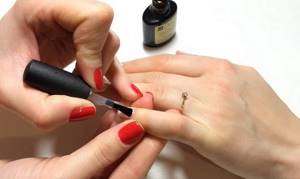
The material of artificial nails has a specific, unpleasant odor. Those with a sensitive sense of smell will find it unpleasant. However, the result that the girl will see after will certainly please her, and the one and a half hour period of extension will remain a thing of the past.
There is one more nuance that clearly confuses girls. It turns out that acrylic cannot be coated with varnishes. This is due to the fact that when removing the color coating, the acetone contained in the nail polish remover damages the surface of the acrylic artificial nail, and it becomes rough.
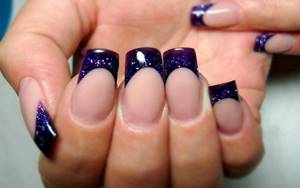
Removal
Removing artificial turf can also be done at home, but you must first take care of the safety of your eyes, since during this process small and sharp particles of acrylic can fly in different directions. You can then use the following instructions:
- Initially, use a nail file to remove the free edge of the acrylic plate; only then can you proceed to removing the outer layer. At the same time, you should not apply force or try to tear it off, as this can lead to injury to the natural nail. To carry out this step, it is recommended to use a tool with a fairly coarse coating.
- Cotton pads are moistened with a special acrylic remover and then wrapped around the nails. The fingers should be additionally wrapped on top with regular aluminum foil to prevent evaporation of the drug and loss of its basic properties.
- After 40-50 minutes, the cotton pads and foil can be removed. The acrylic will acquire a liquid structure; it can be removed with any suitable tool, but this must be done promptly, before it has time to harden again.
- If there are residues of material after the procedure, they can be removed with a swab soaked in a regular acetone-based nail polish remover.
- To complete the removal process, you need to wash your hands thoroughly; it is also recommended to lubricate them with some nourishing or moisturizing cream.
Positive and negative sides of extensions
Positive sides
Many girls doubt and think about how to extend their nails, because they can be done with acrylic or gel. Let's look at the positive aspects of acrylic coating:
- There is no need to paint your nails all the time.
- Acrylic holds tightly even when applied in a thin layer, making it look more natural.
- Removing the acrylic coating is quite easy and the nail remains intact and unharmed. A special liquid dissolves the composition.
- All cracks and irregularities are quickly eliminated without the need to replace them.
- You can apply any pattern or design to acrylic nails.
- Acrylic extensions are also done on the legs. As a result, much less money is spent on manicures and pedicures, since there is no need to do them too often.
- Such material gives scope for fantasy and imagination. To carry out acrylic extensions, you should look at photos of various drawings, and you can implement one of them.
Undesirable consequences of extension
- If cheap materials are used for acrylic extensions, then the nails will have an unpleasant odor.
- After some time, the acrylic still comes off. The gel in this case is more durable.
- Some components cause allergies.
- Too much housework can cause the nail plate to become dull, which will force you to use additional glitter polishes.
Contraindications:
- Damage to the nail plate,
- fungus,
- intense sweating,
- treatment with hormonal pills,
- bronchial asthma.
What is acrylic and how does it differ from gel?
Both gel and acrylic are polymers, the only difference is that they harden under different conditions and acrylic withstands temperature changes much better. The materials used for polymer manicure were borrowed from dentistry, where they were tested for strength and ease of use.
The acrylic extension system consists of powder and liquid monomer, which is also called liquid . liquid – liquid.
A feature of the monomer is a sharp and rather unpleasant odor, so craftsmen working with the polymer must take care of a special hood. It is better to do acrylic manicure at home in a well-ventilated area. There is a monomer with a moderate odor, but, judging by the reviews, this system does not last as well.
When working, a special brush is moistened in the liquid and then dipped into the powder. It is saturated with liquid and turns into a dense plastic drop, which, using the same brush, is applied to the nail plate and leveled with trampling and stretching movements, giving it shape. This must be done quickly, as the polymerization process is underway and the acrylic hardens into a solid plate.
Acrylic gives unlimited possibilities for three-dimensional design. It is easy to repair and completely remove if necessary.
Unlike acrylic, gel polymerization occurs in an ultraviolet lamp. The gel does not have such a pronounced odor. There is also a hybrid of these two materials - acrylic, which combines all the advantages of both.
The choice of acrylic or gel will be dictated by the conditions in which the artist works, as well as his skills and experience. Working with acrylic requires greater skill, speed in small movements and a workstation equipped with a hood.
Also, the client may prefer one or another type of material due to the unpleasant odor of acrylic or the presence of an allergic reaction.
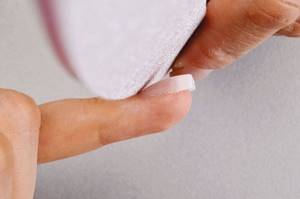
Further nail care
Nail plates do not require special care after manipulation due to the strength of the composition.
To preserve your manicure for a long time, follow these rules:
- High humidity is the reason for artificial nails to peel off. Hand washing is accompanied by diligent drying with a towel, especially the nail plates.
- When handling household chemicals, use gloves.
- To give acrylic nails a natural gloss, they are coated with colorless varnish.
- Use preparations to remove varnish without adding acetone.
- Sometimes an allergy to a synthetic material – acrylic – manifests itself. In case of peeling, redness, itching of the epidermis of the hands, urgently visit a specialist and remove the acrylic coating.
- To maintain the flexibility of the nail, resort to oil baths daily.
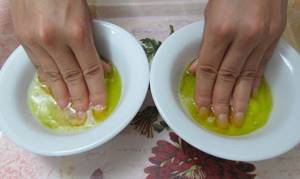
Oil baths - healthy nails
- A balanced diet and quality sleep are important for healthy nails.
If you want to grow your nails, they prefer acrylic. The material is responsible for the strength, beauty and durability of the manicure. A beginner can handle the job. To get an impeccable manicure, the main thing is to follow the sequence of actions and accuracy.
How to make acrylic nails correctly
Artificial materials simulate the shape and size of natural nails. The choice of modeling (acrylic or gel) depends on the user’s experience, preferences and starting capabilities.
The creation of artificial nail plates from acrylic is performed on tips or forms, upper/lower.
Tips are plastic nails, forms are flexible plates. The first method requires the ideal condition of the nail plates: their strength and integrity. For bitten, thinned nails, it is better to stick to the second method.
Preparation
When planning acrylic nails, the extension technology requires a certain pattern.
Nails are prepared in advance for the procedure. Manipulations are carried out:
- Remove cuticle.
- The nail surface is polished with a file to adhere to acrylic and avoid peeling. Removes the shine of the nail, leaving a matte surface.
- Brush off the dust with a brush.
- Disinfect the plates.
- Primer is applied.
Make the transition to acrylic extensions. Choose a modeling method: on tips or forms.
Nail extension with acrylic on tips
The simplicity of acrylic extensions on tips for one-time use. It requires the correct selection of the dimensions of the template shape, attachment to the nail and fixation with acrylic.
If you work with tips, a step-by-step guide will be useful:
- Select the dimensions of the tips. When necessary, file the edges.
- Placing the overlays in the sequence for gluing will allow you to work comfortably.
- Trim the length of the nail to 0.5 mm and file the edge.
- It is preferable to remove the cuticle with cutters.
- A trim manicure is done several days before the planned extension.
- Nails are treated before manipulation, according to the preparation plan.
- Apply glue from the set with tips to the edge of your nail and the template at the fastening area.
- The form is placed at a slight angle and secured for 15 seconds. There should be no bends, gaps, backlashes or bubbles in the fixed part.
- Shorten the excess length with a tip cutter. Use a file to shape the edge of the nozzle and remove the thickness of the tips. This will give acrylic nails a neat look. They are freed from the thickness at the joint, the bulges on the side of the rollers.
- The top of the cover is sanded.
- Dip the brush into the liquid, squeeze out half of the monomer from one side, and pick up an acrylic ball with the other side.
- Place 3 balls: the largest one is in the middle, on the stress area, the second small one is in the growth zone, the third small one is applied to the free edge of the nail. Smooth out from the center to the edges using rubbing movements.
- When the brush grabs the material, it doesn’t hurt to wet it in a liquid liquid.
- Upon completion of the manipulation, the result is examined from the side, resembling a crescent in shape, with the most convex part in the stress zone in the center of the nail.
- The manipulations are repeated for the remaining nails.
- Then the shape and thickness are filed.
- They are freed from excess thickness of the side ridges, at the tips and along the length.
- Polish the length.
- Apply a base and colored varnish and decorate.
Acrylic extension technology on tips
Acrylic nail extensions on top forms
When performing acrylic extensions on the upper forms, follow the step-by-step instructions:
- Hands and tools are treated with disinfectant.
- Hands are prepared in the same way for the procedure as for tips.
- The nail plates are degreased.
- Forms are selected.
- Place 2-3 acrylic balls inside the mold with a brush.
- Press down onto the prepared nail and remove excess material.
- Hold for 7 seconds. Use a brush to shape the nail from the inside.
- Removal of the mold is carried out after polymerization of the acrylic.
- The free edge is processed with a nail file.
- The nail surface is polished with a buff until shiny.
- Lubricate the cuticle with oil.
Acrylic nails on top forms
Acrylic nail extensions are a painstaking and time-consuming procedure. Following the instructions and using high-quality materials and tools creates the conditions for a long-lasting manicure. It is up to the woman to decide which option for acrylic nail extensions to choose.
Modeling the nail plate with gel
- apply primer to the entire nail plate (improves adhesion);
- applying transparent gel 1-2 mm not reaching the side ridges and cuticle (protects the nail);
- drying UV - 2 min, LED - 30 sec;
- removing the sticky layer;
- Since, unlike tips, the length and shape of the free edge have not yet been specified, they will be formed at this stage with gel and a flat brush for modeling nails. The gel is laid out along the length and stretched to the sides along the smile line. A dry brush for nail modeling will help to correct the clear lines of the free edge;
- after polymerization with a larger gel ball, apply a second volumetric layer to the first zone, align the contours and smile line;
- After drying this layer, you can remove the form and begin modeling the second and third zones of the nail.
When working with a gel on a tip, step 5 is skipped and is replaced by applying camouflage gel to the middle part of the nail, slightly extending onto the tip to form a smile line.
Specifics of acrylic nail extension technology
There are two ways to grow nails - acrylic and gel. Each of them has their fans. Let's look at the advantages of acrylic, thanks to which girls prefer it.
Acrylic coating looks natural. It can be extended even onto the most problematic nail plates, thereby strengthening them.
- Acrylic promotes proper nail growth, which prevents ingrown nails.
- Acrylic coating is stronger than gel coating. The period between corrections is 2-3 weeks when the gel requires more frequent treatment.
- When removing acrylic, the natural nail remains virtually undamaged. This is due to the fact that acrylic is dissolved with acetone, so it can be easily removed. Thus, the nail plate is not susceptible to excessive filing, maintaining its natural structure.
- The product dries faster than gel. This mixture does not require additional drying in a UV lamp, which speeds up the entire extension process.
- Acrylic nails look natural, which cannot be said about gel nails.
In addition to the advantages, there are also some disadvantages that every woman should know about before undergoing the procedure.
The acrylic mixture has a specific odor
During the procedure, pay attention to hoods and open windows. A master who constantly works with this ingredient is required to wear a protective mask.
The smell disappears some time after complete decoration and does not reappear during wear. Acrylic, like many other coatings, does not allow oxygen to pass through. Natural nail plates can become lifeless and weak due to lack of oxygen.
- You should not use varnish to design such a coating, because it loses color and can deform the surface if the varnish contains acetone.
- This procedure is contraindicated for pregnant women. Due to hormonal changes, natural nail plates can reject any foreign material.
- This product may cause an allergic reaction. If you are prone to allergies, consult your doctor before the process.
- It is not recommended to do extensions if you have fungal nail diseases.
The best brands of acrylic gels
Today, polygel is produced in various colors, price categories and packaging formats.
Nail service specialists recommend several brands:
| Brand | Advantages | Minuses | Compound | Price |
| TNL Professional is mainly produced in cans |
| Before applying the topcoat, it is recommended to sand the coating with a buffer to avoid the appearance of spots after sawing. |
| from 350 rub. for 18 ml. |
| IriskProfessional is available in both tube and can | excellent strength and plasticity consistency |
|
| from 250 rub. for 8ml |
| Pudding Gel from Bluesky Released only in tube |
|
|
| from 250 rub. for 8 ml. |
| Elpaza |
| small color range |
| from 350 rub. for 30 ml. |
| Tertio |
|
| from 350 rub. for 30ml. |

Acrylic gel, which is convenient, simple and safe to work with, has allowed nail extension artists to expand the range of services they offer. Girls choose polygel nail extensions because of its durability, ease of manicure creation and natural appearance when worn.
Article design: Mila Friedan
Technicians
If the decision was made in favor of acrylic rather than gel extensions, then you will also need to decide on the technique used, since there are different ways to work with this material. It must be taken into account that acrylic hardens very quickly, therefore, when carrying out the procedure at home, all actions must be distinguished by their efficiency.

All options for such extensions are discussed in more detail below:
- Extending nail plates with tips is the fastest option for the procedure, since it will take no more than an hour. This technique is ideal for those with square or fairly wide nails. The only drawback is the impossibility of creating a thin and pointed manicure, since the process of cutting out the desired shape will take too much time and take a significant amount of effort.
- Extension of nail plates on top forms. This technique involves laying out the working material in a special recess, which is located inside the mold, after which it is applied and pressed directly to the nail, ensuring uniformity and reliability of fixation.
- Extension of nail plates on lower forms. To carry out this procedure, you will need to use a brush, using it to lay out small acrylic balls. Using them as the main blank, you can make a whole nail of absolutely any shape and length.
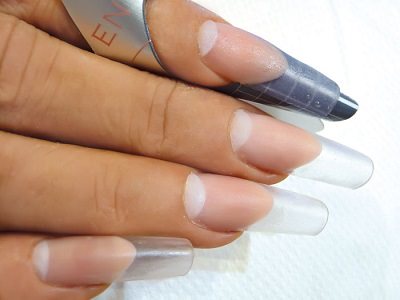
Materials and tools for acrylic extensions
Materials for extensions
The material for extensions is acrylic powder, it can be either regular or camouflage. You will need the following tools:
The main material for extensions is acrylic powder
- liquid monomer (liquid);
- glue for tips;
- top;
- bonder (also called a degreaser);
- primer;
- cuticle remover;
- cuticle oil.
Tools for acrylic extensions
Nail extension mold
- cutter;
- tips;
- forms;
- a respirator, as acrylic has a strong odor;
- nail clippers;
- tweezers;
- buff with medium abrasiveness;
- brush to remove dust;
- container for acrylic;
- pusher or orange stick;
- clothespins to clamp the stressed part;
- paper towels.
Decoration of extended manicure
To add shine to your extended manicure, in addition to polishing, you can apply a special finishing gel to the surface of the nails or cover them with colored varnish, apply a design, or make an applique. After this, you need to treat the cuticle with a special oil to moisturize and nourish.
As for removing extended nails, a special remover is used to soften them. After treating the nail with this solution and wrapping it in foil for 15-20 minutes, the softened nail mass can be removed with a pusher or a wooden stick. After this, the nails can be coated with any strengthening agent.
